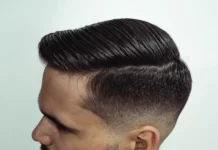 Are you ready to delve into the world of the temple fade haircut? This iconic 90’s look is a fantastic way to incorporate the unique shape of our temples into a stylish hairstyle. But, what exactly is a temple fade, how can you achieve one, and how long does this hairstyle last?
Are you ready to delve into the world of the temple fade haircut? This iconic 90’s look is a fantastic way to incorporate the unique shape of our temples into a stylish hairstyle. But, what exactly is a temple fade, how can you achieve one, and how long does this hairstyle last?
We’ll delve into all these questions and more as we explore this exciting and iconic hairstyle. Let’s dig in!
What Is a Temple Fade?
A temple fade, a beloved, adaptable haircut, can be tailored to suit your unique style. Sporting a modern yet easy-to-maintain look, this haircut starts around the temples, often accentuated with a clean straightening effect. What sets it apart? It’s the sharp, distinctive cut around the temples – a characteristic absent in other haircuts.
So, how do we create this standout look? It all begins with careful tapering around the temples and sideburns. This technique blends the shorter hair on the sides with the longer strands on top, forming a smooth gradient.
Imagine this: you start with hair of uniform length. Then, as you move upward from the base of the head, the hair gradually shortens until it reaches the temples. This shift creates a stunning, sleek effect, unique to the temple fade.
The final step involves blurring the sides, giving the cut a seamless look – a harmonious transition from the short hair on the sides to the longer top. The end result is a haircut that mirrors the effortless charm of an iconic 90s trend reborn for the modern man.
Different Types of Temple Fades
With temple fades, variety reigns supreme. Multiple variants beckon, each packing its own punch, guaranteeing a style that’s sure to resonate with every man. Let’s explore:
- High Fade: This variation takes off from the temples, ascending towards the crown. Longer hair tops it off, making it a perfect fit for those with round or oval faces by providing an elongating effect.
- Low Fade: Beginning at the hairline, it gently tapers towards the temples. The low fade leaves more hair on the sides, softening the features of those with square or angular faces.
- Mid Fade: Launching from the head’s mid-point, this fade rises towards the temples and crown. Its versatility makes it a winner for all face shapes and hair types.
- Skin Fade: This style trims hair down to the bare skin, ensuring a smooth transition from hair to skin. Suited for straight or wavy hair, the skin fade can be customized with various fade lengths.
Every temple fade style holds its unique charm, echoing the timeless essence of this haircut. The question is, which one will you make your own?
How to Maintain a Temple Fade
Maintaining any hairstyle, particularly a temple fade, is paramount. With its defining blend between short sides and longer top, a temple fade necessitates a well-kept freshness. Over time, the clarity of this parting can diminish.
Beware of uneven growth! Hair sprouts at varying rates, potentially altering the fade’s appearance across the head. To ensure perfection, regular upkeep is crucial. A trim and touch-up every 2-4 weeks, contingent on your hair growth rate, can sustain the fade’s freshness and preserve the cut’s shape.
Use the right products and styling methods to maintain hair health and prevent damage. Seek professional advice for the optimal maintenance routine tailored to your hair type and style.
Yes, maintaining a temple fade calls for effort and meticulousness. Yet, with the right tools and techniques, home maintenance becomes a feasible task.
Invest in the right tools. Hair clippers, perhaps a pair of scissors, and voila – you’re equipped to maintain your fade at home. Employ suitable products to ensure your style looks sharp. A decent gel or hair wax helps keep hair in place. A less highlighted point is that sun exposure can harm your hair, especially with a fade. Guard your hair against sun damage by donning a hat, a cap, or using a leave-in conditioner with SPF protection.
While professional barber visits ensure immaculate cuts, monthly visits should suffice. The remaining touch-ups can comfortably be done at home. Maintaining a temple fade may sound daunting, but armed with these tips, you’ll master it in no time.
How Long Does a Temple Fade Last?
A haircut’s lifespan hinges on myriad factors. From your dietary habits and exercise regimen to stress levels and beyond, many variables shape how your hair grows. Each person’s experience is unique – pinpointing a precise timeline for how long a temple fade will stay pristine remains elusive. The care you provide and the products you utilize significantly impact hair growth. A golden rule to remember: both skin and hair deserve top-quality care.
Want your temple fade to retain its panache longer? High-quality products are your best bet. Coupled with regular visits to a proficient barber, this could be the secret sauce to maintain a stylish, healthy, and well-kept look. Shun abrasive styling products, hair dyes, and chemicals, and your hair will reflect its healthier state. After all, a temple fade isn’t just a haircut, it’s a commitment to style and self-care.
Conclusion
And there you have it – a window into the world of temple fades, illuminating the potential of this stylish haircut to become your next statement look. The temple fade is not only a nod to the iconic 90s trend, but it’s also a testament to your personal style and grooming diligence. It encapsulates the essence of a man who appreciates the blend of nostalgia with modern aesthetics and isn’t afraid to invest time in maintaining this polished appearance.
So whether you’re a high fade enthusiast, a low fade aficionado, or a mid-fade or skin fade fan, remember that your chosen style speaks volumes about you. Each trip to the barber or moment spent in front of the mirror is an opportunity to reinvent, to maintain, and to exude confidence with your temple fade. Stand tall, knowing you’re carrying a piece of the classic era, refined for the modern man. Let your temple fade be more than a hairstyle; let it be a symbol of your timeless taste.
















